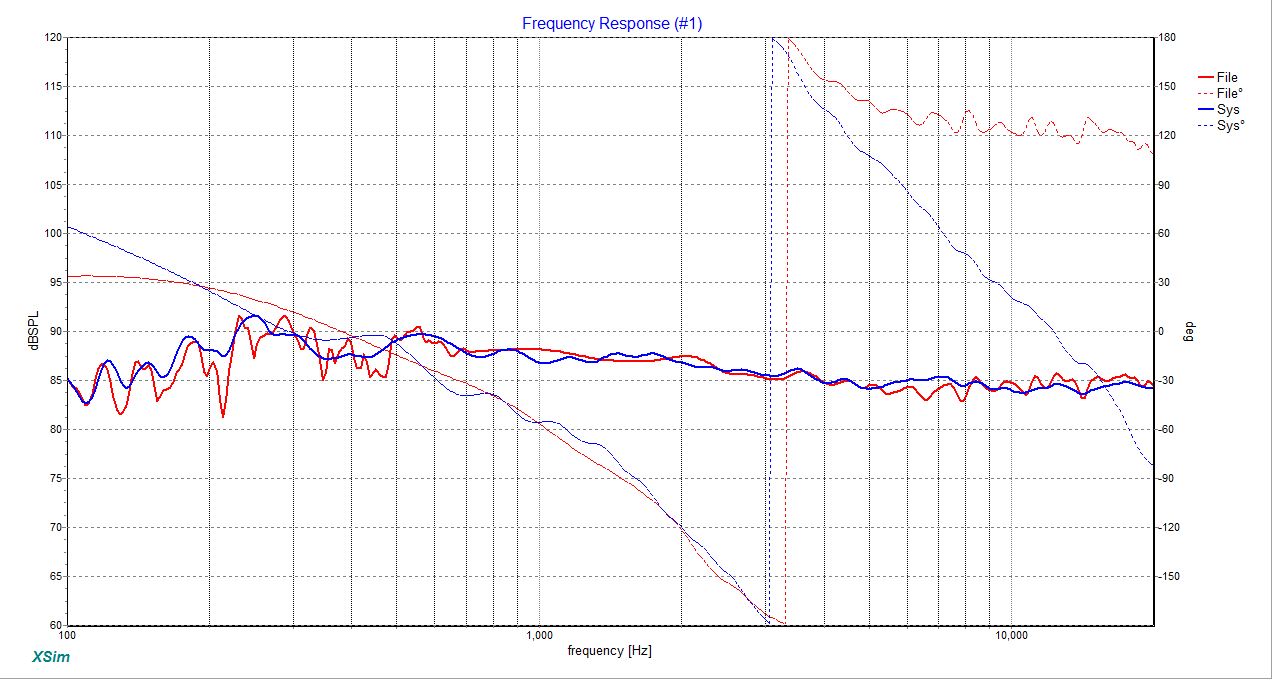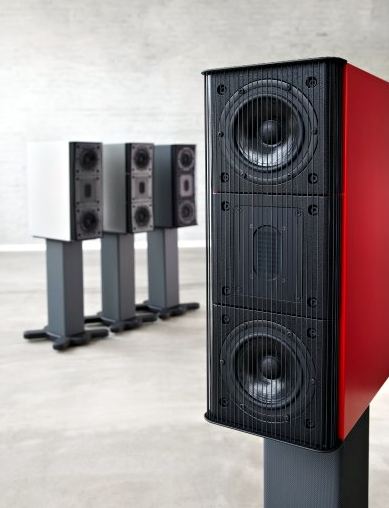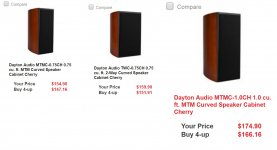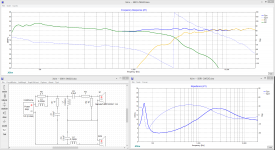I can understand that it's hard to accept that Erik's using his own reasoning rather than someone else's. Perfectly legitimate and quite common among humans. You see, Erik's offering isn't meant for those feeling to be a better designer than he is but for those that are not ready to design one on their own yet, and in the future anyone can modify to their own taste, easily. So I can't see any harm in it, being the way it is now as shown.
Doh Zvu!!!
You are absolutely right!! They align pretty closely so I didn't even think of it. Let me work on that!
I think one of the most curious aspects is the raw driver data for the woofer. As I mentioned elsewhere, I just did not measure the plateau at the top octaves that are in the spec sheets. That changes everything, and why I wonder seriously if there was an engineering change at some point.
I've switched computers, and I'm not living in the same apartment I was when I designed the speakers, so I may have lost the full speaker measurements, as well as now not sure if I can measure as well, but I'll be happy to do this for friends.
Thanks for the obvious pointer.
Erik
You are absolutely right!! They align pretty closely so I didn't even think of it. Let me work on that!
I think one of the most curious aspects is the raw driver data for the woofer. As I mentioned elsewhere, I just did not measure the plateau at the top octaves that are in the spec sheets. That changes everything, and why I wonder seriously if there was an engineering change at some point.
I've switched computers, and I'm not living in the same apartment I was when I designed the speakers, so I may have lost the full speaker measurements, as well as now not sure if I can measure as well, but I'll be happy to do this for friends.
Thanks for the obvious pointer.
Erik
I can understand that it's hard to accept that Erik's using his own reasoning rather than someone else's. Perfectly legitimate and quite common among humans. You see, Erik's offering isn't meant for those feeling to be a better designer than he is but for those that are not ready to design one on their own yet, and in the future anyone can modify to their own taste, easily. So I can't see any harm in it, being the way it is now as shown.
Thanks Lojzek!
That is all I am doing. That's why I included all the information down to simulation files. I did not realize how non-conformist the design would be.
AHA!! Found the images on my blog, which also has a full suite of distortion data.
I had posted this chart, which actually has both the simulation and actual measurements:

I also took a full suite of distortion measurements, (which I had forgotten about) but now no longer know the specific measurement conditions. I think some of this may have been tweeter only, as I was talking to Raal about doing compression and distortion testing on it for him.
The new data is presented as-is. Sorry guys, I took that over a year ago and did not keep better notes than that. BTW, the original name for the SNR-1 was NOES.
You'll also find some waterfall plots, but I think that was for the tweeter only.
Best,
E
I had posted this chart, which actually has both the simulation and actual measurements:

I also took a full suite of distortion measurements, (which I had forgotten about) but now no longer know the specific measurement conditions. I think some of this may have been tweeter only, as I was talking to Raal about doing compression and distortion testing on it for him.
The new data is presented as-is. Sorry guys, I took that over a year ago and did not keep better notes than that. BTW, the original name for the SNR-1 was NOES.
You'll also find some waterfall plots, but I think that was for the tweeter only.
Best,
E
Last edited:
I should point out that I added near field measurements to the XSim I posted here, so below 500 Hz or so you'll notice a difference. I spliced in the port contributions, but I am really not sure I did that right. I will say I was guided by in room response in splicing, not math, so, could definitely have messed it up.
No, you still aren't listening, Erik.
The Scan woofer might work OK on a 6dB, but actually gets much harder on 12dB or even 18dB. We are, after all, not in the business of building LGWAG speakers. We want to be able to play Mendelssohn's Elijah!
You have also missed a trick with the whole concept. This is how you do $500 ribbons with series wired 4 ohm bass for the tidy higher impedance and good dispersion:


Happily, I feel confident a 2.5kHz+ crossover is possible here. Impedance takes a beating, but that is what happens with ill-behaved drivers that force you to depart from optimal values. TBH, I think a Peerless 830874 or 830875 would make more sense. The poly dustcap works better than anything paper. More damping, you see.
Steve,
I may have to charge you for picture rental
Rick Craig
Selah Audio
I should point out that I added near field measurements to the XSim I posted here, so below 500 Hz or so you'll notice a difference. I spliced in the port contributions, but I am really not sure I did that right. I will say I was guided by in room response in splicing, not math, so, could definitely have messed it up.
Splicing is always aproximation. I do it at an end of a project to see quasi anechoic measurements aproximation. What works for me is nearfield measurement of midwoofer (under 2cm distance) and gated farfield measurement of whole loudspeaker (gating at least at 300Hz or lower). Then i merge it between 300-400Hz. Sometimes i do groundplane measurement and merge it to gated farfield - it shows more consistent results because i don't need to measure port output and merge it to nearfield.
Anyway, good gate goes a long way. Point of my post is to get precise quasi anechoic measurements at least on axis to see if your measurements will match with Troelses. Whatever i may think of Troels designs, his measurements are spot on in my experience and it would worry me if my measurements wouldn't match his.
Not claiming that your measurements are faulty, but certainly something to be investigated.
Last edited:
I have nothing against measurement, absolutely.
But for me, "well-measured" speakers never sounds good for my ears.
For example, Troels measurements always have pronounced bass.
The upper middle are weak expressive; high - almost no.
Bad for me
First, I'm not a "bass man". For me, good sounding 50Hz is more than enough.
And I need a little more pronounced upper frequency.
Everyone has their own taste
But I'm 64 and that's for me.
But for me, "well-measured" speakers never sounds good for my ears.
For example, Troels measurements always have pronounced bass.
The upper middle are weak expressive; high - almost no.
Bad for me
First, I'm not a "bass man". For me, good sounding 50Hz is more than enough.
And I need a little more pronounced upper frequency.
Everyone has their own taste
But I'm 64 and that's for me.
You can open a thread about that in which i'll be happy to participate.
In short, my experience is quite different than yours. Speakers that measures well, sound well.
I never said that Troels speakers measures well or bad (i can only say that for a particular design - i could never generalize). I said that his measurements are accurate.
In short, my experience is quite different than yours. Speakers that measures well, sound well.
I never said that Troels speakers measures well or bad (i can only say that for a particular design - i could never generalize). I said that his measurements are accurate.
Last edited:
I should also point out, I have another schematic from Madisound with the same woofer. The woofer measurements are very very close to my own. So, I'm fairly confident that the raw woofer driver, especially around the crossover, is accurate. Plus, I'd hear an exaggerated midrange hump.
It's just not as bad as the specs say.
Best,
E
It's just not as bad as the specs say.
Best,
E
To update this with recent in-room response figures:
A Speaker Maker's Journey: The SNR-1, Room Response and Roon
A Speaker Maker's Journey: The SNR-1, Room Response and Roon
I'll took a go on this crossover (after all the fuzz) to see where it brings me. And considering all things, i don't see the problem actually...
Here is how i would do it (assuming the measurements are on point). A second order serial crossover with BSC (calculated on a guessed baffle width of 25cm) and zorbel, and an Lpad to tame the treble a bit. Included is the XSIM project
Here is how i would do it (assuming the measurements are on point). A second order serial crossover with BSC (calculated on a guessed baffle width of 25cm) and zorbel, and an Lpad to tame the treble a bit. Included is the XSIM project
Attachments
Hi everyone!
I've been absent for a while, but wanted to update this thread with in-room measurements and a discussion about enhancing the results with DSP based equalization. The shocking thing to me really was the amount of bass extension from these little drivers in the room they ended up in.
https://speakermakersjourney.blogspot.com/2021/12/room-speakers-eq.html
It was really interesting to find out that I hit some sort of low bass jackpot when I bought this house.
Best,
Erik
I've been absent for a while, but wanted to update this thread with in-room measurements and a discussion about enhancing the results with DSP based equalization. The shocking thing to me really was the amount of bass extension from these little drivers in the room they ended up in.
https://speakermakersjourney.blogspot.com/2021/12/room-speakers-eq.html
It was really interesting to find out that I hit some sort of low bass jackpot when I bought this house.
Best,
Erik
- Home
- Loudspeakers
- Multi-Way
- SNR-1 : Mundorf / Scanspeak 2 Way

